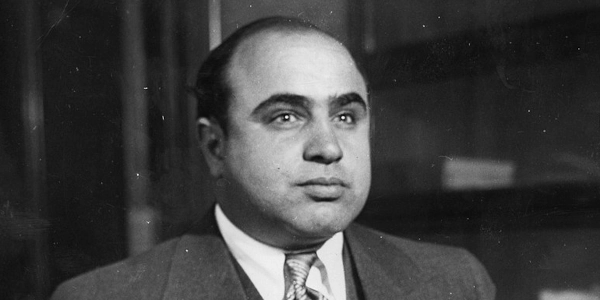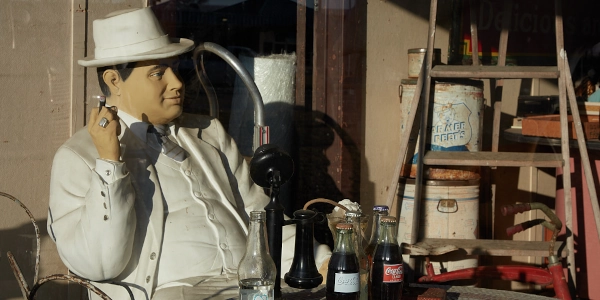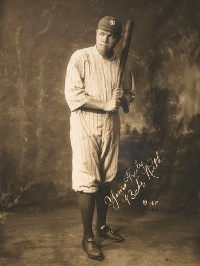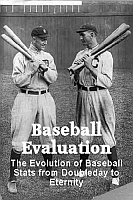Sponsor this page for $75 per year. Your banner or text ad can fill the space above.
Click here to Sponsor the page and how to reserve your ad.
-
Timeline
1929 Detail
February 14, 1929 - In Chicago, Illinois, gangsters working for Al Capone kill seven rivals and citizens in the act known as the St. Valentine's Day Massacre.

Article by Jason Donovan
Chicago, one of America's largest cities, has a long and storied history. Prohibition-era Chicago could be brutal. There was so much money to be made that bloody turf battles were not uncommon. During this time, there were rivers of booze and blood flowing through the city. After becoming desensitized to the violence into a slumber, the city's residents would be traumatically awakened on a cold morning in February 1929. This morning, a battle for control over the city's bootlegging would be decided at the Saint Valentine's Day Massacre.
The initial groundwork for what would end in the explosion of lead that woke Chicagoans from their sleep started in 1920. The Volstead Act came into effect on 17 January 1920 after final passage of the 18th Amendment occurred in 1919. The Volstead Act made the production, transportation, and sale of intoxicating beverages illegal. Arguably, the main problem faced by the law was that there was no effective and robust enforcement arm. There needed to be a strong enforcement arm because the public at large and many in government did not support the law.
The lack of support meant the public still wanted their drink. Just like any other time in history when something becomes illegal, a black market sprouts out of society's dark underbelly. One of the significant issues with a black market is that the regulations are, in many cases, enforced with violence. As the amount of money to be made increases, so does the bloodletting. Prohibition-era Chicago was no exception. The economics were plain to see.
The Genna's operation, for example, was hugely profitable and straightforward. The brothers bought the ingredients and equipment for basically pennies. But those in the overcrowded tenement buildings where the stills were set up took on a potentially explosive risk. As a result of these conditions, the brothers would pay up to $15 a day, which is approximately $274 as of 2024. While this might not seem extraordinary today, at this time in history, that amount of money could make a huge difference in a new immigrant's life. On the other hand, the brothers could make that back with the sale of one bottle, which could cost a speakeasy owner a price per bottle of more than $15. With billions in today's money to be made, gangs and groups would form to control their parts of the city.
There were many cogs in Chicago's underworld and three major gangs that were involved in the massacre in some form or fashion. They were the Southside gang, the Northside gang, and Southside allies, the Genna brothers. The Southside was led by Johnny Torrio and his underboss Alphonse Capone. The Genna brothers' base of operation was Taylor Street, also known as "Little Sicily." The brothers' main issue with the North Side Gang was territorial issues.

Territorial Issues
This issue over territory comes from the fact that the Gennas expanded into North Side territory, and Dion O'Banion, the leader of the gang, took umbrage with their actions. Learning that the Genna brothers were with Torrio. Things could have taken a much different turn at this moment in history. Since a truce was in effect, O'Banion went to Torrio and asked him to reign in the Genna brother's activities. Torrio did nothing. This inaction would come back to haunt Torrio and may have been the spark that started the slow-burning fuse that would end in the massacre.
Dion O'Banion was unhappy, and in a possible act of revenge that would end in arrests, he set up Torrio. This incident refers to the Sieben Brewers police raid. O'Banion received information that a police raid on the brewery was forthcoming. As a result, O'Banion sold his interest in the brewery. Then, after the deal was done, O'Banion tipped off the police about Torrio. Even though both O'Banion and Torrio were arrested, unlike Torrio, who lost the brewery, O'Banion had no previous convictions; thus, he received a slap on the wrist. After all this, O'Banion refused to do two things: one was to forgive a large gambling debt that the Genna brothers had racked up, and the second was he did not honor Torrio's request to pay him back the money for the brewery sale. These were the straws that broke the camel's back. O'Banion was on borrowed time; he did not know it yet.
On 10 November 1924, his time was up. While in Schofield's Flowers, the flower shop he co-owned and used as his headquarters, is where his road would end. On the day of his death, three men came into the shop. When one of the men shook his hand, the other two men, one of which is thought to be Frankie Yale and the second an associate of the Genna brothers, shot the North Side leader six times. The war was on.
The North Siders' revenge was relatively quick; the first Genna to die as a result of O'Banion's assassination was Angelo Genna. He would meet his end on 26 May 1925. After a short car chase, he was shot and killed. It has been alleged that four North Siders were in the pursuing car. These are said to be gang leaders George "Bugs" Moran and Vincent "The Schemer" Drucci.
Angelo Genna's death would be just the start for the Genna family. Within eight months, the family would be decimated. A second death would come on 13 June 1925 when police killed Mike Genna during a shootout after a high-speed chase through the south side of Chicago. The third would come on 8 July 1925 when Tony Genna, known as "The Gentlemen," was shot dead on a street corner on the West Side. After this string of deaths, the remaining Gennas fled America to their native Sicily.

Capone Continues the War
The war was far from over. A huge attack on Capone's Chicago headquarters, the Hawthorne Hotel, would occur on 20 September 1926. Hymie Weiss executed this hit on Capone. He achieved this by using a continuous line of ten cars packed with his men wielding Thompson submachine guns, firing nearly 1,000 rounds. Capone was not injured in the attack, but an innocent bystander was and as a result, "… Capone gave her $5000 for her medical bills," over $88,000 in 2024. This event seemed to anger Capone when he answered a reporter's question of who he thought was responsible when he famously stated "Watch the morgue. They'll show up there."
Capone would make good on his threat. His iron fist would come down on 11 October 1926 when Hymie Weiss was gunned down in front of the same flower shop where O'Banion met his end. Two leaders are now left. By 4 April 1927, that number would be down to Moran alone after Drucci was shot and killed by a police officer during a "verbal assault." The war would continue.
In 1925, an event set in motion a series of events that contributed to the war. This chain started with Tony Lombardo becoming Capone's advisor. By some accounts, Lombardo was officially Capone's consigliere. By 1926, Capone was using Lombardo to seize control of the Chicago chapter of the Unione Siciliana, a national Italian Immigrant association. These actions angered the Unione's president, New York gangster Frankie Yale. Yale, at one time, was one of Capone's closest friends, but their relationship had already begun to sour over the previous few years. The Unione operated as an important front for the illicit activities of the nation's underworld. As a result, anyone who controlled the Unione would wield a large amount of power within that world. Capone would stop at nothing to increase his power.
Yale and Capone's friendship was not the only one that soured over the years. Another would be that of Lombardo and Joe Aiello, leader of another gang. They were once close friends and business partners in a cheese-importing enterprise, the seed money of $100,000 which Capone himself allegedly supplied. Their relationship came to its breaking point when Capone appointed Lombardo head of the Unione. This turn of events incensed Aiello and was the moment a deadly feud kicked off between Aiello, Lombardo, and Capone.
Due to Capone's belligerent behavior within Chicago's underworld, alliances were formed to oppose him. One of these alliances that Capone's actions forced to come about in 1927 was one between the Aiellos and Moran. This joining of forces would soon bear fruit.
As 1928 started, the dispute over the Unione between Yale, Lombardo, and Capone was still rumbling on. It would come to a head when Lombardo refused Yale's request to relinquish the presidency of the Unione to Aiello. Capone would allegedly remove this thorn in his side that Yale had become. On 1 July, he was gunned down in New York City. Retaliation would come soon.
The cold hand of retribution would reach out and hit back at Capone when Aiello ordered a hit on Lombardo. The hit would come on 7 September 1928. It would be on this date that Lombardo and two out of his three bodyguards would be shot to death on a bustling Chicago street. Lombardo's death, combined with multiple attempts on ally Jack McGurn's life, was too much. The bullets fired in these events were only precursors of what Capone's famous revenge would bring about roughly five months later, with a lead Valentine's Day card.
The Massacre Itself and the Tax Evasion Aftermath
By the beginning of 1929, Capone had had enough and wanted to clear the board with one swift and brutal stroke. Depending on the source, McGurn is said to have planned this operation with Capone's blessing. In contrast, other sources say that it was Capone's brainchild. It does not matter who planned it; the plan was meticulously detailed. Some sources say McGurn traced the North Siders headquarters back to a garage at 2122 North Clark Street under the S.M.C. Cartage Company. The clock was ticking.
The plan was set in motion on 13 February when Capone asked another bootlegger to call Moran and tell him he had a deal for him on a shipment of hijacked Old Log Cabin, which was said to be "very good liquor." The two men agreed upon a reasonable price of $57 a case. The time for delivery was set for 10:30 a.m. the following day.
On the morning of the massacre, two of Capone's men were stationed in an apartment across the street from the garage to act as a lookout. The lookout sent a signal when they saw Moran enter the garage. The signal was sent in error. Four, possibly five, men in a stolen police car, two dressed as police officers, pulled up to the garage and acted as if they were raiding it. As the car pulled up, the four gunmen jumped out and entered the garage. The four gunmen were said to be Fred "Killer" Burke, John Scalise, Albert Anselmi, and Joseph Lolordo.
On the other hand, seven North Side gang members were waiting in the garage. These were the gang's enforcers, brothers Frank and Pete Gusenberg, John May, Albert Weinshank, James Clark, Adam Heyer, and a gang associate Dr. Reinhart Schwimmer, a former optometrist. These seven men were told to line up along the brick wall. They did as they were told, knowing they would likely get a slap on the wrist, whatever the charge. As the seven men stood there, the four gunmen pulled out their weapons, which included two Thompson submachine guns. These guns were weapons of war. The Thompson held 20 to 30 rounds of .45APC and had a rate of fire of 600 to 725 rounds per minute. It was a favorite of the military and law enforcement for decades, highly noted for its "stopping power." The men lined up against the wall didn't stand a chance of leaving that building alive. They never knew what hit them.
As the four gunmen opened fire, the distinctive sound of "The Chicago Typewriter" cut through the frigid morning air. All seven men dropped to the floor. Six of these men would die instantly, but Frank Gusenberg would survive long enough for the cops to ask him, "Who shot you?" To which he answered the famous answer, "Nobody shot me." He would succumb to his injuries a few hours later. Observing the gangster's code of silence known as "omert&aacite," which translates as "code of silence." Keeping quiet till the very end. One survivor, a German Shepard, was said to have alerted neighbors via his howling and barking. The carnage and brutality of this heinous act would come to haunt Capone.
In the aftermath of the murders, the city and nation would wake to the horrors of the underworld around them. The citizenry had grown accustomed to shootouts and the murder of a gangster or two at a time, but this had crossed a red line from which there was no coming back. There was outrage throughout the nation and calls for a crackdown on gangs and gangsters.
Now, it must be said that everyone knew the killings were Capone's handy work. Even though this was one of the first cases in history that used ballistics as evidence, law enforcement could not find enough evidence to link the crime to Capone. Before the slayings, Capone had widespread public support. But now, a glaring hot light was shown on Capone's activities. This spotlight was a problem for him. His problem was that the underworld must be concealed in darkness to facilitate the money they were making.
Due to this attack and the spotlight it brought from federal law enforcement as they started to look into Capone's finances, he would remain a free man for now. The Internal Revenue Service (IRS) opened an investigation carried out by their Special Intelligence Unit, which found receipts showing cash transactions stemming from his illegal gambling rackets. Because of what the IRS investigations uncovered, Uncle Sam calculated that Mr. Capone owed him $200,000 in back taxes, equivalent to $4,117,105 in 2024 dollars. In the fall of 1931, Capone was indicted in a tax evasion case on twenty-two counts. After he realized no plea deal was forthcoming, Capone tried to financially influence the jury. The judge was alerted to this and discreetly replaced the jury before the trial began.
Unfortunately for Capone, on 17 October 1931, his luck ran out. On this day, he was found guilty of five counts. As a result of this guilty verdict, he was sentenced to eleven years in jail, fined $50,000, and charged $7,692 in court costs, approximately $1,029,276 and $158,343 as of 2024, respectively. He was also ordered to pay back taxes with interest. He would not be the only person to be taken down as a result of the massacre. Another person to be taken down was Jack McGurn. With Capone off the board, McGurn lost his ally and became vulnerable. This venerability would increase when in April 1930, the chairman of the Chicago Crime Commission published a nationwide list of corrupt public enemies in Chicago and its suburbs. "Machine Gun" Jack McGurn was fourth on the list. The notoriety McGurn received from the list caused his fellow Outfit members to turn their backs on him. The spotlight was too high."
By 15 February 1936, Mcgurn was persona non grata with most of his former associates. On this day, McGurn and two other men went to a bowling alley at 805 Milwaukee Ave. Soon after entering, a third man came in and yelled, "If you move, you die." After this, the two men who came in with McGurn and the third man formed a semicircle around McGurn and gunned him down. It has been reported that a Valentine was left on the body that stated, "You lost your dough and handsome houses, but things could be worse you know at least you haven't lost your trousers."
The St. Valentine's Day massacre came about, as many things in history have done, as a product of the time. The massacre was driven by one man's unceasing lust for dominance and power. It was the violent convulsion that resulted from the Machiavellian attitude and environment that was the underworld of the time. Ruthlessness and a might makes right attitude was how things were done in the 1920's. At that time, society was willing to tolerate some violence because the bootleggers who were involved made sure they could still wet their whistle in the dry desert that America had become. The massacre changed everything, and that tolerance was gone. The country would not ever be the same.
Photo above: Al Capone, 1930, Chicago FBI. Photo courtesy Wikipedia Commons. Below: Likeness of Al Capone outside John E. Piedt and Sons Antique Store in Benton Harbor, Carol M. Highsmith. Courtesy Library of Congress. Info source: ‚ÄúChicago Outfit Leadership Timeline‚ÄĚ. No Author. Nationalcrimesyndicate.com; Osborn, Jacob, ‚ÄúThe Bizarre Story of Al Capone‚Äôs Missing Millions‚ÄĚ manofmany.com; Schipper, Mark, ‚ÄúA North Side Tour of Chicago‚Äôs Sordid Gangster History‚ÄĚ. Chicago Magazine. 13 June 2017; ‚ÄúJohnny Torrio‚ÄĚ MafiaHistory.com; ‚ÄúThe Genna Brothers‚ÄĚ, Myalcaponemuseum.com; Chicago Tribune ‚ÄúThe End Is Near‚ÄĚ. Chicago Tribune 11 August. 2021, Originally Published 26 August 1997; Seaver, Carl, ‚ÄúDean O‚ÄôBanion and the Gangs of Prohibition-Era Chicago‚ÄĚ, Historydefined.net; Grossman, Ron, ‚ÄúShot dead in his flower shop, bootlegger Dean O‚ÄôBanion got a classic gangland sendoff‚ÄĚ, ‚ÄėChicago Tribune. 10 November 2024; ‚ÄúThe Genna Brothers,‚ÄĚ Cemeteryguide.com; Benzkofer, Stephan, ‚ÄúAl Capone‚Äôs battles for Cicero included ballots and bullets," Chicago Tribune. 20 March, 2015; ‚ÄúOn this day in 1926 Hymie Weiss Attempted a hit on Al Capone," Nationalcrimesyndicate.com; ‚ÄúHymie Weiss‚ÄĚ Al Capone Museum; Adam ‚ÄúThe Death of Hymie Weiss: Al Capone‚Äôs revenge‚ÄĚ 23 March 2009, Mysteriouschicago.com; Contributed Content ‚ÄúChicago Originals‚ÄĚ, Chicago Tribune. 10 August 2021; Knight, Kennedy, ‚ÄúThe St. Valentine‚Äôs Day Massacre: What Happened Before That Caused This Infamous Crime‚ÄĚ, The Mob Museum Blog. 14 February. 2014. Dean, Hayley, ‚ÄúTony Lombardo: Died On This Day In 1928, Aged 36,‚ÄĚ Nationalcrimesyndicate.com; ‚ÄúA Complete Guide To The St. Valentine‚Äôs Day Massacre Of 1929,‚ÄĚ Nationalcrimestyndicate.com; ‚ÄúThe Hawthorne Hotel‚ÄĚ, Al Capone Museum; Rosenberg, Jennifer. ‚ÄúSt. Valentines Day Massacre,‚ÄĚ ThoughtCo.com, 3 Feb 2019; Tate, Aden, ‚ÄúWhat Ammo Does The Thompson Use‚ÄĚ, ‚ÄėThe Gun Zone‚Äô 1 May 2024; ‚ÄúHow The St. Valentine‚Äôs Day Massacre Unfolded and Stoked America,‚ÄĚ PBS-WTTW.com; ‚ÄúOmerta, N,‚ÄĚ Cambridge Dictionary; Hparkins, ‚ÄúThe Taxman Cometh: U.S. v. Alphonse Capone,‚ÄĚ 26 July 2011. National Archives; Dickson, Mike, ‚ÄúMachine Gun Jack McGurn - St. Valentines Day Massacre,‚ÄĚ Americanmafiahistory.com; ‚ÄúCapone Tax Evasion Trial: 90 Years Ago, The T-Man Had The Goods On Mob Chief - Part 1: Witnesses Detail Capone‚Äôs Untaxed Income From An Array Of Illegal Operations,‚ÄĚ The Mob Museum Blog‚Äô 16 October 2021.

History Photo Bomb






